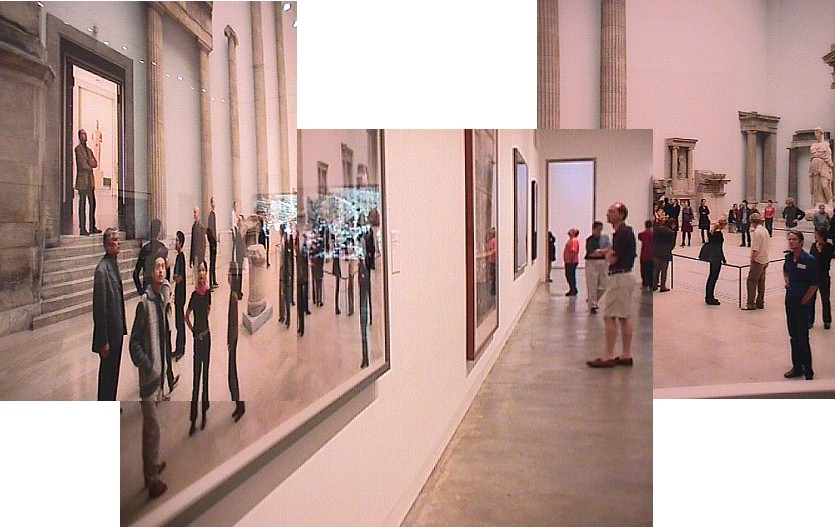2006.03.18 10:42
Iconography, or the problem of representation
Alejadro wrote:
we forecast the development of a discipline of form with a double agenda, operating simultaneously as an organizational device and as a communicative device
Of all the images within this thread, what is mostly only seen are images/iconography that operate as a 'communicative devise'. There has been very little attention given to images/iconography as 'organizational devise'.
This makes me wonder whether there even is a real 'double agenda' at work here.
The terminal communicates as a wave, but is the terminal really organized like a wave? Does the terminal communicate as a wave because 'waves' of people move through it? It seems you could say that. But is the building itself really organized like a wave? Waves are for the most part ephemeral and non-symmetrical, aren't they?
A stadium looks like a nest (actually it looks more like basket weaving), but is the stadium really organized like a nest? Do large waves of people converge on a nest and then sit (on some eggs) and watch and then fly away? [If the answer is yes, then we very much have an example of reenactionary architecturism, although real nests are not organized to handle more than a few occupants.)
Gnomes with pointy hats may have a iconographic communicative relationship with a group of high pitched roof buildings, but are these buildings really organized like gnomes apart from being randomly scattered like the gnomes in the picture? Have there been studies showing that gnomes organize things in a randomly scattered manner?
How do you organize a building based on a sneaker? Moreover, what type of building would be appropriate to organize like a sneaker, a building to be used by lots of sneaky people?
I wonder what a real 'double agenda' building looks like.
| |
2007.03.12 17:05
...and speaking of random tangents
"In a sense Asimov, Heinlein, and the masters of American Science Fiction are not really writing of science at all . . . They're writing a kind of fantasy fiction about the future, closer to the Western and the Thriller, but it has nothing really to do with science . . . Freud pointed out that you have to distinguish between analytic activity. which by and large is what the sciences are, and synthetic activities which are what the arts are. The trouble with the Heinlein-Asimov type of Science Fiction is that it's completely synthetic. Freud also said that synthetic activities are a sign of immaturity, and I think that's where classical Science Fiction falls down."
--Ballard, Speculation, 1969.
Upon first reading this passage, thoughts of how Piranesi's Il Campo Marzio dell'Antica Roma and particularly the Ichnographia Campi Martii have been largely misinterpreted by 20th century architectural 'scholarship' came to mind. The synthetic quality of Piranesi's archaeology (before archaeology was formalized into a science) is all the critics/theoreticians saw, and they completely discounted the analytical aspect of Piranesi's archaeology. Basically, a non-analytical analysis resulted in a synthetic interpretation.
The wonderful thing about Il Campo Marzio dell'Antica Roma (including the Ichnographia Campus Martius) is that the distinction between the analytical and the synthetic is never manifest--the work seamlessly embodies both natures.
[note to self: think about an updated republication of "Theatrics Times Two" and "Theatrics Times Two, too".]
"Science now, in fact, is the largest producer of fiction. A hundred years ago, or even fifty years ago even, science took its raw material from nature. A scientist worked out the boiling point of a gas or the distance a star is away from the Earth, whereas nowadays, particularly in the social, psychological sciences, the raw material of science is a fiction invented by the scientists. You know, they work out why people chew gum or something of this kind . . . so the psychological and social sciences are spewing out an enormous amount of fiction. They're the major producers of fiction. It's not the writers anymore."
--Ballard, Speculation, 1969.
2007.03.12 21:46
...and speaking of random tangents
As to "It raced so fast the pulse exited a specially prepared chamber before it even finished entering it," that book may already be written---perhaps either Einstein's General Relativity or Special Relativity. (But don't quote me on that.)
As it stands, to me, the sentence relates the pulse being quickly stretched between the entry and exit points of the chamber.
But the sentence may not even be correctly describing what really happened:
Perhaps it meant to say the pulse completely exited the chamber at a time in the past relative to its entry time.
or
Perhaps it meant to say the pulse bilocated, being at two locations but not at the same time; again, the second space/time occurred before the first space/time.
This is what the whole time warp theory is about. Or at least it's what it used to be all about. Or maybe theories quickly exit before they finish entering.
| |
2007.05.18 14:57
lost endings
What I see in LOST is the same type of convoluted (complicated; intricately involved) storyline filled with clandestine, sort of encyclopedic clues. What seems somewhat unique to LOST though is its way of character development via real time portrayal and flashback. This operation manifests (at least) a double theater, which is a very fecund, indeed baroque, story-telling vehicle that is not often used.
2007.09.15

Museum Trip 2002.09.15.003
2008.04.02 17:02
what is gothic that is not ornament? what is baroque, if not ornament?
Gothic is a passion play, whereas Baroque is a double theater.
|